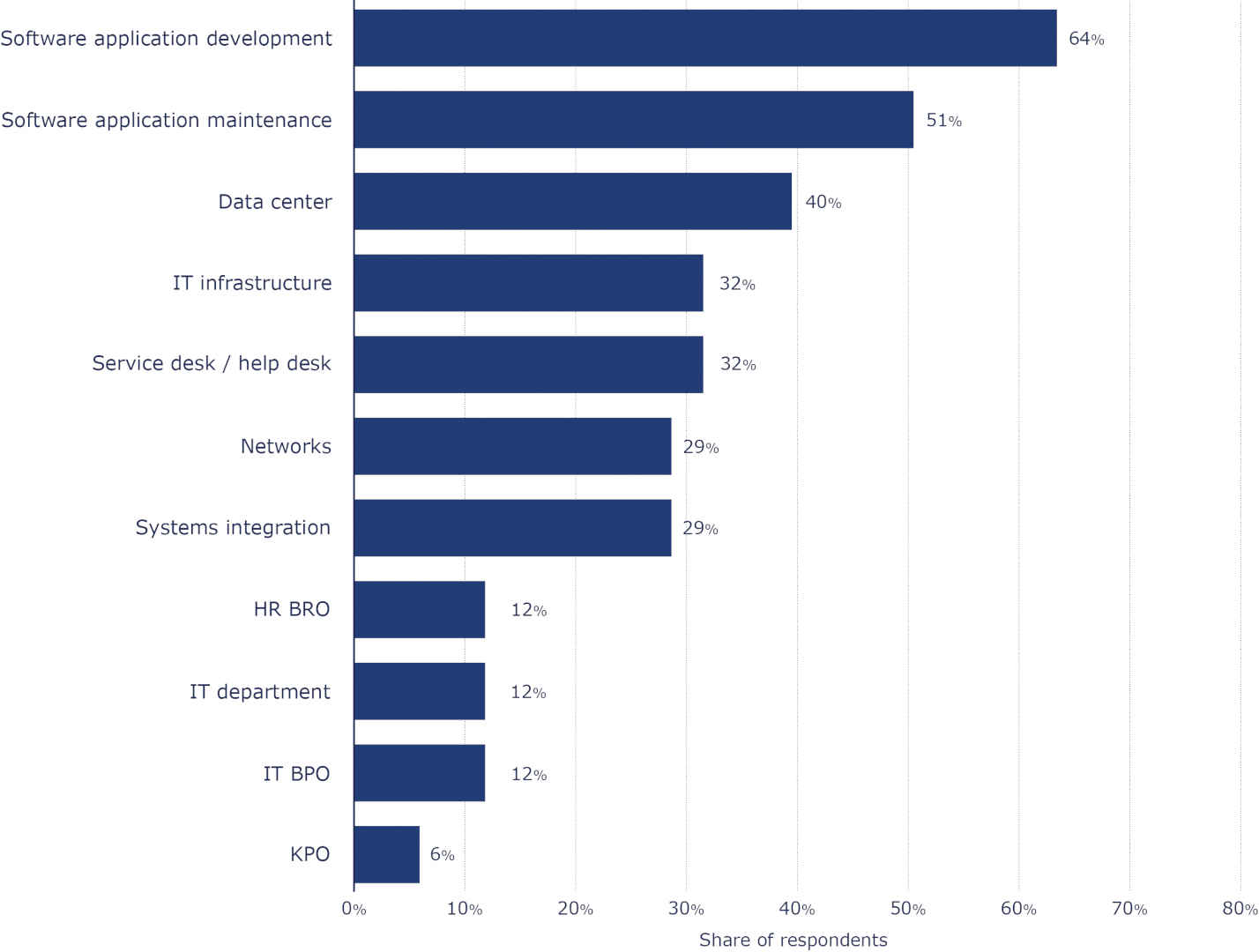The global pandemic launched a wave of interest in hybrid and remote work. What many people may not realize is that the software industry had paved the way for a globalized digital workforce since the 1980s, when North American and European companies began hiring software development talent in remote countries with lower wage rates for developer talent. Today, competition is increasing among traditional outsourcing firms as many companies weigh the pros and cons of outsourcing vs nearshoring.
Today’s research indicates that 52% of companies with software development projects have used outsourcing. The most popular types of outsourced projects mirror the demands of today’s mobile and data-driven world, with software app development, app maintenance, and data centers topping the list.

The Rise of Nearshoring
In 1997, Softek, a Mexican IT firm, was the first company to introduce "nearshoring" offerings as a way to compete in the US marketplace with large outsourcing firms from India and other parts of Asia.
Nearshoring is also sometimes called on-shoring. Both terms refer to contracting for development services with companies in the same or similar time zones and hemispheres. To be precise, if not a bit confusing, nearshoring is still outsourcing because it refers to contracting for work outside of the host company. Nearshoring is the practice of using companies closer to or even inside of the host company country, in many cases the US or Canada.
In both outsourcing and nearshoring, the service package usually includes overall project management. Sometimes companies don't need to outsource their entire project; they may only need an expert in a specific specialization at different phases.
When companies hire freelancers or consultant talent to work on particular parts of the project without a project management overview, this is typically called "team augmentation". Outsourcing contractors may handle bringing in experts to augment teams from time to time as well.
To simplify comparisons for this post, we define outsourcing as working with teams in almost opposite time zones with significant cultural differences, such as India or the Philippines.
Differences Between Outsourcing vs Nearshoring
Outsourcing and nearshoring are two distinct practices that allow companies to utilize expertise from a remote foreign location. Companies can tap into a global talent pool and benefit from competitive rates for labor and other services.
On the other hand, nearshoring involves partnering with a business or source in the same or similar time zone to take advantage of easier communication and lower the cost of in-person meetings. Nearshoring allows companies to minimize expenses while engaging in strategic initiatives within their regions.
Outsourcing advantages
Outsourcing software development can bring several advantages to organizations, starting with cost savings.
Lower HR Overhead
Outsourcing offers many advantages, the most obvious being a lower labor cost. Outsourcing projects to overseas vendors can significantly reduce labor and other operating expenses. These savings can help organizations maintain their margins even with smaller budgets.
Another major advantage of outsourcing is that it eliminates the need for hiring staff and managing them internally. Companies do not have to worry about recruiting, training, paying benefits, or dealing with employee-related issues when outsourcing services and operations.
Access to Global Talent Pools
Many organizations are now turning towards international vendors for access to global talent. Different perspectives can help organizations boost innovation and bring new ideas into their company that might otherwise not be possible.
The demand for software talent is strong, and some companies may need to look beyond their own borders to keep projects on schedule. Larger talent pools help organizations to tap into specialized knowledge outside their local market.
Increase efficiency and shorten timelines
When teams need to staff up or lean out, outsourcing can also provide that flexibility, saving companies from expensive hiring and lay-off cycles.
Faster Turnaround Time
When teams are working well together, outsourcing can reduce turnaround times. The outsourced team can focus solely on the specific task and avoid being reassigned for other functions within the client company.
Companies can also leverage time zone differences. Teams across time zones can support an almost 24/7 development cycle, where local teams pick up in the morning on work done the night before in another time zone.
Outsourcing tradeoffs
Overall, outsourcing software development can be an excellent way for companies to complete projects while keeping costs low. However, it is not a perfect solution for all cases. Let's look at some potential disadvantages.
Lack of Project Control
When companies outsource their projects, they often lose the ability to oversee and manage the day-to-day progress, relying on external experts to deliver results. With the wrong partner, this can lead to project delays, subpar quality, or other unexpected problems that can be difficult to address.
Intellectual Property Protection
When outsourcing software development, companies need to be sure to take steps to protect any intellectual property. All parties need to agree upon contractual terms and conditions that protect both sides from any unauthorized use of data, information, and products created during development.
Risk of Expensive Failures
If the outside partner fails to deliver results, companies may have to cover costs related to contract termination, legal fees, additional resources needed to complete the project, and more.
Companies must also consider security risks associated with data breaches or cyber threats from outside sources when outsourcing services overseas. Sensitive information traveling through different networks and systems is at increased risk of unauthorized access or data theft.
Culture Clash
When outsourcing projects overseas, communication or cultural differences may make it difficult for companies and partners to understand each other's needs and goals. Misunderstandings can cause tension which may negatively affect productivity and performance over time.
Nearshoring Advantages
Both outsourcing and nearshoring share similar risks - loss of project control, IP protection, and loss due to failure. However, nearshoring does offer some advantages over outsourcing.
Easier Communication and Shared Cultural Context
With nearshoring, businesses can benefit from improved direct contact between their staff and foreign employees in the same or similar time zone, allowing for a smooth exchange of ideas and information.
Time zone proximity also makes it much easier to collaborate in real-time on projects, which can help increase efficiency.
Working with individuals that share familiar cultural values also means there is less chance of misunderstandings, allowing for a more productive working relationship.
Like outsourcing, nearshoring helps companies take advantage of talent outside the organization. Access to a more extensive selection of skills opens up new opportunities for growth and innovation.
Nearshoring in the same country simplifies legal contracts and compliance because all parties are subject to the same laws and regulations.
Moving Ahead
At Sharkbyte, we have years of experience consulting clients on their software project roadmap and different options for outsourcing vs. nearshoring. Every project is different. Your decision depends on several variables such as the type of project, time frame, and costs. We are happy to help you weigh your options. Contact us today!



